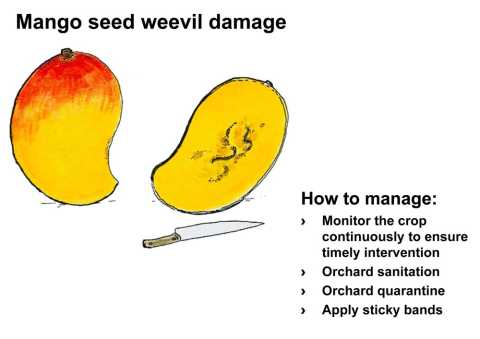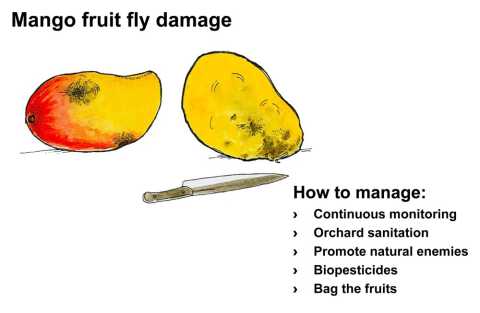Pest and Disease Management
In farming systems, preventive methods based on proper crop and habitat management are encouraged. Direct methods of control are reserved for emergencies only. Note: synthetic insecticides and fungicides are not allowed in organic mango production.
The most destructive mango pests are the mango seed weevil and the mango fruit fly, common nearly in all mango producing areas.
Mango seed weevil (Sternochetus mangiferae)

Mango seed weevil, also called the mango stone weevil, is one of the major pests of mangoes in sub-Saharan Africa. The larva, which is the damaging stage of the pest, enters the fruit by burrowing through the flesh into the seeds, where it feeds until pupation, destroying the seed. Early attack (when the fruit is forming) leads to premature fruit fall. If the attacks occur at a later stage, fruit infestation is very difficult to detect, since there are no external signs of infestation.
When the adult emerges, it tunnels through the flesh, leaving a hole in the fruit skin which may serve as an entry point for secondary fungal infections, greatly affecting the quality of the fruit. This is particularly a problem because, in many instances, weevil attack remains undetected in the field, and is first noticed in storage or when cutting the fruit.
The weevil spreads into clean areas through the movement of infested fruit for propagation or consumption. It can, however, be managed by:
- Continuous monitoring to ensure timely intervention is important, for instance, a weevil attack can be detected by monitoring for egg-laying marks on young fruit. Regular fruit scouting is important to detect adult activity during fruit growth.
- Ensuring good orchard sanitation by collecting and destroying all scattered mango seeds and fallen fruit. All collected fruit and seeds should be buried deeply (about 50 cm deep).
- Ensuring orchard quarantine by restricting movement of fruit from old orchards or areas known to have mango seed weevils to areas where young orchards, free of seed weevil, have been established.
- Applying sticky bands at the upper end of tree trunks when the trees start flowering to reduce migration of weevils to branches for egg laying.
Mango fruit flies (Bactrocera invadens)

Female fruit flies puncture the fruit skin and lay eggs that develop into maggots (larvae) in the flesh of the fruit after hatching. The larvae feed on the fruit and cause it to drop prematurely and destroy the pulp of the fruit. Generally the fruit falls to the ground as, or just before, the maggots pupate. In fruit for export, fruit flies cause indirect losses resulting from quarantine restrictions that are imposed by importing countries to prevent introduction of fruit flies. Nearly all fruit fly species are quarantine pests. Fruit flies attack soft, fleshy fruit of a wide variety of fruit and vegetables. Management strategies of fruit flies include:
- Continuous monitoring of fruit flies to determine when they arrive in the orchard and to decide when treatment is needed. Monitoring can be done using bait traps like the ‘bucket trap’ (Also see transparency 4-18). The farmer should, however, be able to identify fruit flies from among other trapped insects. Pheromone traps are also available to attract male fruit flies, hence reducing reproducing populations.
- Orchard sanitation is important as poorly managed or abandoned orchards can result in buildup of fruit fly populations. All fruit with dimples and oozing, clear sap should regularly (e.g. twice a week for the entire season) be removed from the tree as well as all rotten fruit from the ground. The maggots are killed by burning or tying collected fruit in black plastic bags and exposing them to the heat of the sun for some hours. The fruit can also be buried deep, at least 50 cm (about two feet), to prevent emerging adult flies from reaching the soil surface.
- Several natural enemies can contribute to the suppression of fruit flies. Major natural enemies are parasitic wasps (e.g. Bracon spp.) that attack the maggots of fruit flies and predators such as rove beetles, weaver ants, spiders, and birds and bats. In particular, weaver ants have been shown to be very efficient in protecting fruit trees from pests, including fruit flies. These ants pray on fruit flies, but most importantly, their presence and foraging activity hinders the fruit flies from laying eggs, resulting in reduced fruit fly damage, as shown in mango orchards in Benin. Although natural enemies alone do not give satisfactory control of fruit flies, efforts should be made to protect them, and to complement their effect on fruit flies with other management options. Dill, parsley, yarrow, zinnia, clover, alfalfa, parsley, cosmos, sunflower and marigold are flowering crops that attract the native wasp populations and provide good habitats for them.
- Biopesticides such as a spray pyrethrum solution is effective in controlling fruit flies. Other plant extracts like neem, garlic, chilli and tephrosia can also be used. The biopesticides can also kill beneficial insects like bees if they are sprayed directly. Therefore, it is best to spray in the evenings after most of the bees are back in their hives (after 6 pm).
- Bagging prevents fruit flies from laying eggs on the fruit (See also transparency 4-19). In addition, the bag provides physical protection from mechanical injuries (scars and scratches). Although laborious, it is cheap, safe and gives a more reliable estimate of the projected harvest. Bagging not only protects fruit from fruit fly damage, but protects the fruit from physical damage improving the market appearance of the fruit. However, it is only practicable on small trees.
Other common pests of mangoes include scales, mealy bugs, aphids and mango flies.
- Scales suck the plant sap. Feeding by scales may cause yellowing of leaves followed by leaf drop, poor growth, dieback of branches, fruit drop and blemishes on fruit. Heavily infested young trees may die. In addition, soft scales excrete honeydew, causing growth of sooty mould. In heavy infestations, fruit and leaves are heavily coated with sooty mould, turning black.
- Mealy bugs (Rastrococcus invadens) suck sap from the leaves, branches, flowers and fruit. They excrete honeydew that develops into black sooty mould.
- Whiteflies and Blackflies (Aleurocanthus woglumi) can also be regulated through the beneficial insects. They suck sap from leaves and may weaken the plants when numbers are high. They excrete large amount of honeydew where sooty mould develops. High numbers of these insects can almost blacken trees, reducing photosynthesis and also may cause leaf drop.
- Mango Aphids (Toxoptera odinae) live in clusters sucking sap on the underside of young leaves, on petioles, young branches and fruit. Their feeding causes slight rolling, or twisting of the leaf midrib. Sooty mould growing on honeydew produced by the aphids may cover leaves, twigs and fruit, reducing its market value.
These are all sucking insects that live on leaves, young branches and buds and can cause great damage. However, all of them have natural enemies such as lady beetle larva, wasps, spiders and parasitic fungi. Therefore, improving diversity, by planting wild flower strips in the orchard and hedge rows, will enhance the beneficial insects. By wrapping a smooth, slippery plastic band around the trunk or any sticky substance will also restrict the movement of the mobile pests. In case of heavy infestation it is possible to control by spraying a 1 % soap solution with 1 % pure alcohol, with an application of paraffin oil (white oil) as a 3 % water emulsion or with a plant extract of neem or other botanicals.
Most diseases of mango are caused by either fungi or bacteria. The first preventive measure is, therefore, to obtain healthy vegetative propagation material free of these infections.
- Anthracnose is caused by the fungus Collectrichum gloeosporioides and is the most common disease of mango, especially in regions that have high rainfall and heavy dews. It affects leaves, stems and floral panicle, but the fruit receive the most damage. The fungus causes brown spots on leaves and black spots on fruit and flowers and makes the young branches brittle. The infestation can be reduced if dead material (branches, leaves and infested fruit) is removed from the orchard. After harvest, anthracnose can be controlled if the fruit is given a water bath for 3 to 5 minutes at 55° C.
- Bacterial infection with Erwinia spp. can infect the stem, branches, flowers and young fruit. The symptoms are similar to the spots on the fruit and leaves as in anthracnose. These bacteria can survive in the soil. When it rains, the bacteria spores get under the leaves and fruit through rain splash (when soil particles get pushed into the air on contact with raindrops). Cover crops reduce rain splash, thus reducing the infestation of the leaves and fruit. An active and living soil can also reduce bacterial multiplication because Erwinia spp. does not explosively propagate in soil.
- Powdery mildew (Oidium mangiferae) can damage young fruit and flowers. This fungus appears mostly in warm, humid weather (temperature of 22° C and relative humidity of 65 %). In severe attacks, the entire blossom panicle may be involved and fruit fail to set (affecting yields). An open, well-ventilated and faster drying orchard that is regularly pruned hinders the mildew infestation.
- Leaf spot disease (Cercospora mangiferae) - causes spots on leaves and fruit. An open, well-ventilated and well-drained orchard is the best preventive measure against Cercospora infestation. Infested fruit is not marketable.
In acute cases, mildew, anthracnose and leaf spot diseases can be regulated with sulphur or copper preparations, which are allowed in organic and non-organic farming. However, in case of certified organic mango production, the farmers should consult their certification body for guidance before applying any of those preparations.
Email: Editor@agricinafrica.com

Comments
Post a Comment